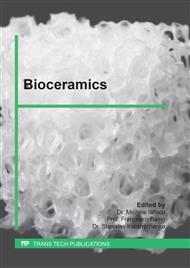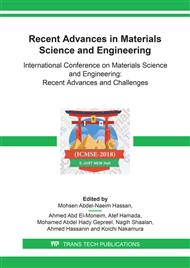[1]
Gahlert M, Gudehus T, Eichhorn S, Steinhauser E, Kniha H, et al. Biomechanical and histomorphometric comparison between zirconia implants with varying surface textures and titanium implant in the maxilla of miniature pigs. Clin Oral Implants Res. 2007; 18: 662-668.
DOI: 10.1111/j.1600-0501.2007.01401.x
Google Scholar
[2]
Brånemark P, Adell R, Breine U, Hansson B, Lindström J, Ohlsson A. Intraosseous anchorage of dental prostheses. I. Experimental studies. Scand J Plast Reconstr Surg. 1969; 3:81–100.
DOI: 10.3109/02844316909036699
Google Scholar
[3]
Bosshardt, D. D., Chappuis, V., & Buser, D. Osseointegration of titanium, titanium alloy and zirconia dental implants: Current knowledge and open questions. Periodontology 2000. 2017; 73(1), 22–40.
DOI: 10.1111/prd.12179
Google Scholar
[4]
Ashi Chug, Sagrika Shukla, Lanka Mahesh and Sanjay Jadwani. Osseointegration—Molecular events at the bone–implant interface: A review. Journal of Oral and Maxillofacial Surgery, Medicine, and Pathology.2013; 25 1– 4.
DOI: 10.1016/j.ajoms.2012.01.008
Google Scholar
[5]
Puleo DA, Nanci A. Understanding and controlling the bone–implant interface. Biomaterials. 1999; 20:2311–21.
DOI: 10.1016/s0142-9612(99)00160-x
Google Scholar
[6]
Ratner BD, Bryant SJ. Biomaterials: where we have been and where we are going. Annu Rev Biomed Eng 2004; 6:41–75.
DOI: 10.1146/annurev.bioeng.6.040803.140027
Google Scholar
[7]
Wilson CJ, Clegg RE, Leavesley DL, Pearey MJ. Meditation of biomaterial cell interactions by adsorbed proteins: a review. Tissue Eng. 2005; 11:1–18.
DOI: 10.1089/ten.2005.11.1
Google Scholar
[8]
Albrektsson T, Branemark PI, Hansson HA, Lindstrom J. Osseointegrated titanium implants: requirements for ensuring a longlasting, direct bone-toimplant anchorage in man. Acta Orthop Scand. 1981; 52: 155-70.
DOI: 10.3109/17453678108991776
Google Scholar
[9]
Albrektsson T, Wennerberg A. Oral implant surfaces: part I – review focusing on topographic and chemical properties of different surfaces and in vivo responses to them. Int J Prosthodont. 2004a; 17: 536-43.
Google Scholar
[10]
Albrektsson T, Wennerberg A. Oral implant surfaces: part II – review focusing on clinical knowledge of different surfaces. Int J Prosthodont. 2004b; 17: 544-64.].
Google Scholar
[11]
Langhoff JD, Voelter K, Scharnweber D, Schnabelrauch M, Schlottig F, Hefti T, et al. Comparison of chemically and pharmaceutically modified titanium and zirconia implant surfaces in dentistry: a study in sheep. Int J Oral Maxillofac Surg 2008; 37: 1125-32.
DOI: 10.1016/j.ijom.2008.09.008
Google Scholar
[12]
Zechner W, Tangi S, Tapper G, Fürst G, Bernhart T, Haas R, et al. Influence of platelet rich plasma on osseous healing of dental implants: a histological and histomorphometry study in minipigs. Int J Oral Maxillofac Implants. 2003; 18: 15-22.
DOI: 10.1034/j.1600-0501.2003.00859.x
Google Scholar
[13]
GinnySoon, Belinda Pingguan-Murphy, Khin Wee Lai and Sheikh Ali Akbar. Review of zirconia-based bioceramic: Surface modification and cellular response. Ceramics International. 2016; 42:12543–12555.
DOI: 10.1016/j.ceramint.2016.05.077
Google Scholar
[14]
Koklubo T, Kim HM, Kawashita M. Novel bioactive materials with different mechanical properties. Biomaterials. 2003; 13: 2161-75.
DOI: 10.1016/s0142-9612(03)00044-9
Google Scholar
[15]
Kaur G, Pandey OP, Singh K, Homa D, Scott B, Pickrell G. A review of bioactive glasses: their structure, properties, fabrication, and apatite formation. J Biomed Mater Res A. 2014; 102:254–274.
DOI: 10.1002/jbm.a.34690
Google Scholar
[16]
Hisbergues M, Vendeville S, Vendeville P. Zirconia: established facts and perspectives for a biomaterial in dental implantology. J Biomed Mater Res B Appl Biomater. 2009; 88 (2):519–529.
DOI: 10.1002/jbm.b.31147
Google Scholar
[17]
Depprich R, Zipprich H, Ommerborn M, et al. Osseointegration of zirconia implants compared with titanium: an in vivo study. Head Face Med. 2008; 4:30.
DOI: 10.1186/1746-160x-4-30
Google Scholar
[18]
Andreiotelli M, Wenz HJ, Kohal RJ. Are ceramic implants a viable alternative to titanium implants? A systematic literature review. Clin Oral Implants Res. 2009; 20:32–47.
DOI: 10.1111/j.1600-0501.2009.01785.x
Google Scholar
[19]
Dena Hashim, Norbert Cionca, Delphine S. Courvoisier and Andrea Mombelli. A systematic review of the clinical survival of zirconia implants. Clin Oral Invest. 2016; 20:1403–1417.
DOI: 10.1007/s00784-016-1853-9
Google Scholar
[20]
Lyon D, Chevalier J, Gremillard L, Cam C. Zirconia as a Biomaterial. Compr Biomater. 2011; 20:95–108.
Google Scholar
[21]
Obradovic-Djuricic K, Medić V, Dodić S, et al. Dilemmas in zirconia bonding: A review. Srp Arh Celok Lek. 2013; 141:395–401.
DOI: 10.2298/sarh1306395o
Google Scholar
[22]
Aboushelib MN, Kleverlaan CJ, Feilzer AJ. Selective infiltration-etching technique for a strong and durable bond of resin cements to zirconia-based materials. J Prosthet Dent. 2007; 98: 379-88.
DOI: 10.1016/s0022-3913(07)60123-1
Google Scholar
[23]
Noro A, Kaneko M, Murata I, Yoshinari M. Influence of surface topography and surface physicochemistry on wettability of zirconia (tetragonal zirconia polycrystal). J Biomed Mater Res - Part B Appl Biomater. 2013; 101:355–363.
DOI: 10.1002/jbm.b.32846
Google Scholar
[24]
Aboushelib MN, Matinlinna JP, Salameh Z, Ounsi HF. Innovations in bonding to zirconia-based materials : Part I. Dent Mater. 2008; 24:1268–1272.
DOI: 10.1016/j.dental.2008.02.010
Google Scholar
[25]
Conrad HJ, Seong W-J, Pesun IJ. Current ceramic materials and systems with clinical recommendations: a systematic review. J Prosthet Dent. 2007; 98:389–404.
DOI: 10.1016/s0022-3913(07)60124-3
Google Scholar
[26]
Chevalier J, Gremillard L. Ceramics for medical applications: A picture for the next 20 years. J Eur Ceram Soc. 2009; 29:1245–1255.
DOI: 10.1016/j.jeurceramsoc.2008.08.025
Google Scholar
[27]
Saulacic N, Erdosi R, Bosshardt DD, Gruber R, Buser D. Acid and alkaline etching of sandblasted zirconia implants: a histomorphometric study in miniature pigs. Clin Implant Dent Relat Res. 2014; 16: 313–322.
DOI: 10.1111/cid.12070
Google Scholar
[28]
. Aboushelib M, Feilzer A. New surface treatment for zirconia based materials. European patent application, No 050773969; (2006).
Google Scholar
[29]
Gören S. Gökbayrak H, Altıntaş S. Production of Hydroxylapatite from Animal Bone. Key Eng Mater. 2004; 264-8: 1949-52.
DOI: 10.4028/www.scientific.net/kem.264-268.1949
Google Scholar
[30]
Parasuraman S, Raveendran R, Kesavan R. Blood sample collection in small laboratory animals. J Pharmacol Pharmacother. 2010; 1: 87-93.
Google Scholar
[31]
Anitua EA. Enhancement of osseointegration by generating a dynamic implant surface. J Oral Implantol. 2006; 32: 72-6.
DOI: 10.1563/736.1
Google Scholar
[32]
Takayuki M, Salvi GE, Offenbacher S, Felton DA, Cooper LF. Cell and matrix reactions at titanium implants in surgically prepared rat tibiae. Int J Oral Maxillofac Implants. 1997; 12: 472-85.
Google Scholar
[33]
Buser D, Schenk RK, Steinemann S, Fiorellini JP, Fox CH, Stich H. Influence of surface characteristics on bone integration of titanium implants. A histomorphometric study in miniature pigs. J Biomed Mater Res. 1991; 25: 889-902.
DOI: 10.1002/jbm.820250708
Google Scholar
[34]
Orban BJ, Bhaskar SN. Oral histology and embryology.11th ed. Saint Louis: Mosby; (1991).
Google Scholar
[35]
Leslie E, Geoffrey J, James M. Statistical analysis. In: Interpretation and uses of medical statistics. 4th ed. Oxford Scientific Publications, 1991. Pp.411-6.].
Google Scholar
[36]
Kirkpatrick LA, Feeney BC. A simple guide to IBM SPSS statistics for version 20.0. Student ed. Belmont, Calif: Wadsworth, Cengage Learning, 2013. Pp 115.
Google Scholar
[37]
Lee J, Aoki H. Hydroxyapatite coating on Ti plate by a dipping method. Biomed Mater Eng. 1995; 5(2):49–58.
Google Scholar
[38]
Kuroda K, Ichino R, Okido M, Takai O. Hydroxyapatite coating on titanium by thermal substrate method in aqueous solution. J Biomed Mater Res. 2002; 59(2):390–397.
DOI: 10.1002/jbm.10002
Google Scholar
[39]
Tamura M, Endo K, Maida T, Ohno H. Hydroxyapatite film coating by thermally induced liquid-phase deposition method for titanium implants. Dent Mater. 2006; 25(1):32–38.
DOI: 10.4012/dmj.25.32
Google Scholar
[40]
Han JY, Yu ZT, Zhou L. Hydroxyapatite/titania composite bioactivity coating processed by the sol-gel method. Biomed Mater. 2008; 3(4):044109.
DOI: 10.1088/1748-6041/3/4/044109
Google Scholar
[41]
Yuanhuai He, Yuqin Zhang, Jin Zhang, Yehua Jiang and Rong Zhou. Fabrication and characterization of Ti-13Nb-13Zr alloy with radial porous Ti-HA coatings for bone implants. Materials Letters. 2017; 209: 543–546.
DOI: 10.1016/j.matlet.2017.08.098
Google Scholar
[42]
Rahul Sasidharan Pillaia, Matteo Frasnellia and Vincenzo M. Sglavoa. HA/β-TCP plasma sprayed coatings on Ti substrate for biomedical applications. Ceramics International. 2018; 44: 1328–1333.
DOI: 10.1016/j.ceramint.2017.08.113
Google Scholar
[43]
Weinlander M, Kenney EB, Lekovic V, Beumer J, Moy PK, Lewis S. Histomorphometry of bone apposition around three types of endosseous dental implants. Int J Oral Maxillofac Implants. 1992; 7: 491-6.
Google Scholar
[44]
Gottlander M, Albrektsson T, Carlsson V. A histomorphometric study of unthreaded HA-coated and titanium-coated implants in rabbit bone. Int J Oral Maxillofac Implants. 1992; 7: 485-90.
DOI: 10.1034/j.1600-0501.1992.030204.x
Google Scholar
[45]
Wong M, Eulenberger J, Schenk R, Hunziker E. Effect of surface topology on the osseointegration of implant materials in trabecular bone. J Biomed Mater Res. 1995; 29: 1567-75.
DOI: 10.1002/jbm.820291213
Google Scholar
[46]
Takashi S, Shunsuke F, Yasuaki N, Iwao N, Takashi N. Ability of zirconia double coated with titanium and hydroxyapatite to bond to bone under load-bearing conditions. Biomaterials. 2006; 27: 996-1002.
DOI: 10.1016/j.biomaterials.2005.07.026
Google Scholar
[47]
Bigi A1, Fini M, Bracci B, Boanini E, Torricelli P, Giavaresi G, et al. The response of bone to nanocrystalline hydroxyapatite-coated Ti13Nb11Zr alloy in an animal model. Biomaterials. 2008; 29: 1730-6.
DOI: 10.1016/j.biomaterials.2007.12.011
Google Scholar
[48]
Hirota M, Hayakawa T, Ohkubo C, Sato M, Hara H, Toyama Tand Tanaka Y.Bone responses to zirconia implants with a thin carbonate-containing hydroxyapatite coating using a molecular precursor method.J Biomed Mater Res B Appl Biomater. 2014; 102(6):1277-88.
DOI: 10.1002/jbm.b.33112
Google Scholar
[49]
Y. Cho, J. Hong, H. Ryoo, D. Kim, J. Park, and J. Han.Osteogenic Responses to Zirconia with Hydroxyapatite Coating by Aerosol Deposition.Journal of Dental Research. 2015; 94(3):491–499.
DOI: 10.1177/0022034514566432
Google Scholar
[50]
Stefani CM, Machado MA, Sallum EA, Sallum AW, Toledo S, Nociti H Jr. Platelet-derived growth factor/Insulin like growth factor-1 combination and bone regeneration around implants placed into extraction sockets: a histometric study in dogs. Implant Dent. 2000; 9: 126-30.
DOI: 10.1097/00008505-200009020-00004
Google Scholar
[51]
St John TA, Vaccaro AR, Sah AP, Schaefer M, Berta SC, Albert T, et al. Physical and monetary costs associated with autogenous bone graft harvesting. Am J Orthop. 2003; 32: 18-23.
Google Scholar
[52]
Tayapongsak P, O'Brien DA. Monteiro CB, Arceo DL. Autologous fibrin adhesive in mandibular reconstruction with particulate cancellous bone and marrow. J Oral Maxillofac Surg. 1994; 52: 161-5.
DOI: 10.1016/0278-2391(94)90401-4
Google Scholar
[53]
Slater M, Patava J, Kingham K, Mason RS. Involvement of platelets in stimulating osteogenic activity. J Orthop Res. 1995; 13: 655-63.
DOI: 10.1002/jor.1100130504
Google Scholar
[54]
Wang HJ, Wan HL, Yang TS, Wang DS, Chen TM, Chang DM. Acceleration of skin graft healing by growth factors. Burns. 1996; 22: 10-4.
DOI: 10.1016/0305-4179(95)00079-8
Google Scholar
[55]
Steed DL. The role of growth factors in wound healing. Surg Clin North Am. 1997; 77: 575-86.
Google Scholar
[56]
Garcia RV, Gabrielli MA, Hochuli-Vieira E, Spolidorio LC, Filho JG, Neto FA, de Cardoso LA, Shibli JA.Effect of platelet-rich plasma on peri-implant bone repair: a histologic study in dogs.J Oral Implantol. 2010; 36(4):281-90.
DOI: 10.1563/aaid-joi-d-09-00056
Google Scholar
[57]
Seiko Ohba, Wei Wang, Soichiro Itoh , Yuzo Takagi, Akiko Nagai and Kimihiro Yamashita. Acceleration of new bone formation by an electrically polarized hydroxyapatite microgranule/platelet-rich plasma composite. Acta Biomaterialia. 2012; 8:2778–2787.
DOI: 10.1016/j.actbio.2012.04.015
Google Scholar
[58]
Rachit Agarwal and Andrés J. Garcíaa. Biomaterial strategies for engineering implants for enhanced osseointegration and bone repair. Adv Drug Deliv Rev. 2015 November 1; 94: 53–62.
DOI: 10.1016/j.addr.2015.03.013
Google Scholar
[59]
Siebers MC, ter Brugge PJ, Walboomers XF, Jansen JA. Integrins as linker proteins between osteoblasts and bone replacing materials A critical review. Biomaterials. 2005; 26: 137-46.
DOI: 10.1016/j.biomaterials.2004.02.021
Google Scholar



